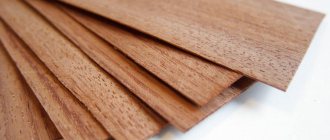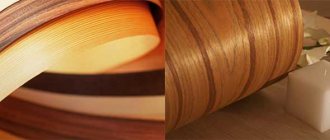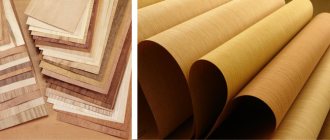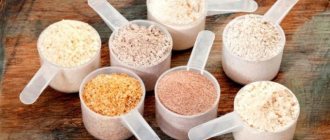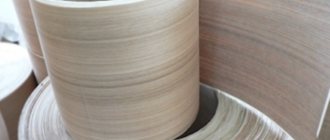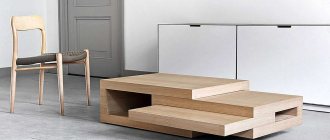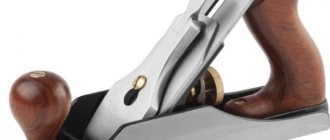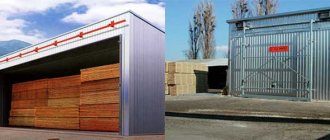Veneer refers to wood materials that have the form of thin sheets of wood, the thickness of which ranges from 0.5-3.0 mm. Veneer is usually glued to wood panels or fiberboard, thus giving the material a more aesthetic and attractive appearance.
Scheme for laying and marking veneer.
Types of raw materials
Veneer manufacturers use wood of various species, with interesting colors and textures. Wood shades vary from white, creamy, light brown to chocolate and bright red. The most commonly used types of wood with a beautiful texture are:
- Pine - wood belongs to the category of soft species, veneer is inexpensive, light in color, is immune to fungi, and releases phytoncides into the atmosphere. However, wear resistance is quite low; products with pine veneer must be treated with care;
- Birch is a common tree in Russia. Its wood is inexpensive and belongs to hardwood. Birch veneer has a pleasant color of natural wood, but it is easily tinted, and if desired, you can get many new shades;
- Oak is a hardwood that is not afraid of high humidity and is resistant to insects. Oak veneers mostly have dark brown tones, but there is a variety of white oak with sandy and light brown wood shades with small inclusions;
- Karelian birch is a rare wood and belongs to the hard species. The veneer has a beige color with a hint of mother-of-pearl. Used for the production of exclusive and expensive products;
- Linden is a soft wood with a delicate yellowish-pinkish tint. Linden veneer is used in the manufacture of inexpensive furniture;
- Cherry is a softwood that has a reddish-brown hue that may darken over time. Cherry veneer looks noble and elegant and is used in the manufacture of luxury furniture;
- Maple - its wood is classified as hard wood. Maple veneer is successfully used to decorate products made from less valuable wood species. It has a light or light yellow tint. Of particular value is the bird's eye texture characteristic of maple. Maple veneer, like wood, has good resonant properties, which is why it is often used for making musical instruments.
Veneer can be made from many other types of wood. Moreover, even from inexpensive raw materials it is possible to obtain plates that are difficult to distinguish from expensive types of wood in appearance.
Distinctive characteristics
The following features will help you distinguish peeled veneer from analogues of other types:
- Lowest thickness. In other words, this type of material is the thinnest.
- If twisted wood is used, the decorative properties of the material increase significantly.
- There are large gaps between the later and earlier wood.
- Price. It is the lowest precisely because of the peculiarities of production. If more expensive raw materials are used (cedar, larch), the cost will be higher. But if compared with other production methods, the price will still be lower.
Preparation of raw materials
The logs and their segments - logs, which are used in the manufacture of veneer, must meet certain size requirements. For the production of laminated plywood, the length of the logs should be from 0.8 to 3.2 m, and for veneer – from 1.5 m. The diameter of the logs does not play a big role. The maximum dimensions directly depend on the capabilities of the equipment. Preparatory work consists of sawing ridges, removing bark and carrying out heat treatment. The parts are immersed in steam tanks or huge baths with hot water for a period of several hours to two to three days, depending on the type and hardness of the wood.
Material purchase
Depending on the type of veneer being produced, suitable raw materials are selected:
- glued plywood - alder, birch, linden, aspen, pine, spruce, cedar, fir, larch;
- wood-laminated plastic (chipboard) - birch;
- sliced veneer - oak, beech, maple, apple, birch;
- peeled veneer - birch, beech, alder, linden, aspen, mahogany, spruce, pine, larch, ash.
It is possible to ensure production with raw materials by establishing a procurement process from local wood producers. An alternative way would be to lease a forest plot. This will allow you to procure raw materials yourself, bypassing intermediaries.
Equipment for the production of
In the 19th century, the first mechanical devices for cutting veneer appeared; before that, it was produced manually, sawing logs with a saw. Nowadays, almost the entire production process is automated, veneer manufacturing enterprises are equipped with high-tech equipment, but professional skills are still at a premium.
The main types of veneer production equipment can be divided into three categories:
- Peeling machines - allow you to produce sheets with a thickness of 1.5 to 5 mm from any type of wood. They are usually equipped with an automatic log setting function. To increase productivity, the machines are equipped with hydraulic lifts with a center finder, which combines the axes of rotation of the workpiece and centering shafts.
- Veneer planing machines - allow you to create thin sheets of expensive and hardwood. The machines are horizontal, vertical and inclined. Such machines resemble huge planes, only the shavings must be of a certain size.
- Sawmills - used for the production of sawn veneer - lamellas.
The line of equipment for the production of veneer also includes machines for stitching veneer, veneer repairing machines, for cutting veneer strips and drying chambers
Normalization of quality and dimensions of peeled veneer
5.1. Veneer repair
The quality of plywood is determined by the quality of the outer sheets. Knots are the main variety-forming defects.
More than 50% of birch veneer sheets and 100% of coniferous veneer sheets contain knots.
Rice. 29 Veneering machines
The best way to eliminate them is to cut them down and seal them with inserts made of high-quality veneer. On average, 20–25% of peeled veneer sheets are repaired. The patches are usually oval in shape, 30–60 mm long, must be free of defects and have the same grain direction as the veneer sheet. To repair veneer, veneer repairing machines are used (Fig. 29).
The machine works as follows: first, using a clamp and an upper undercut, the defective area is cut out of the veneer sheets. Then the patch is cut out and inserted under pressure into a solid sheet. The patch is held in place by tension. The shape of the patches can be oval, rhombic, etc., and the size can be from 25×15 to 100×60 mm.
Rice. 30 The relative position of the tools in the veneer cutting machine: 1 - upper notch; 2 - pusher; 3 - lower notch; 4 - feeder.
In modified machines, the patch is not only inserted under pressure, but also glued. The tight fit of the patch into the hole is achieved by coordinating the sizes of the notches used both for cutting out the defective area and for making a patch from a strip of veneer. In this case, a tension of 0.1–0.2 mm must be ensured in the resulting joint, due to which the patch will be held in the hole of the veneer sheet without the use of glue. To maintain the density of the joint, it is necessary to make patches from veneer with a moisture content of no higher than 3–5%. The relative position of the main elements of the veneer repair machine is shown in Figure 30. The productivity of the veneer repair machine P, sheets per hour, is determined by the formula
where τр is the duration of the auxiliary operation; K is the coefficient of computer time utilization; n — number of patches on one sheet (up to 10); τ1, τ2 — time spent, respectively, on installing the patch and moving the sheet, s.
Typically the productivity of these machines is up to 120 sheets per hour. With a large number of veneer repair machines, a conveyor belt can be used to stack and sort repaired sheets.
Veneer manufacturing technology
Based on the production method, veneer is divided into three types - peeled, sawn and planed. The condition of the wood is essential for obtaining high-quality material. After preparing the logs, a suitable processing method is selected.
Manufacturing of peeled veneer
The technology for producing peeled veneer involves removing a layer of wood from a rotating piece. Preliminary hydrothermal treatment enhances the plastic characteristics of wood, this avoids the occurrence of cracks on the underside of the sheet. It is necessary to choose the optimal temperature for the baths, since too high a degree of heating can lead to softening of the fibers and the formation of a fleecy surface.
During the peeling process, the blocks rotate, and the cutting knives make translational movements relative to the axis of rotation of the workpiece. The diameter of the block gradually decreases. As a result, it takes on the shape of a cylinder, which is called a pencil. The tape formed during peeling is cut with special scissors, then the finished plates are stacked. Rotary cut veneer is mainly used for plywood cladding, for finishing doors and stairs, and in the production of matches.
Manufacturing of sliced veneer
Sliced veneer is a cut of a thin layer of wood with a beautiful texture pattern. This type of veneer is produced by planing prepared wooden blocks on veneer cutting machines. To do this, the log is sawn lengthwise into two halves and determined with a possible pattern. If necessary, the ridge is cut in half again to obtain the desired pattern. The operating principle of the machine is that the workpiece is fixed on a movable frame, and a horizontal knife cuts off the plate with each pass of the frame. Then the workpiece is fed forward. The thickness of the resulting sheet is from 0.2 to 5 mm.
Production of sawn veneer
The technology for manufacturing sawn veneer consists of sawing prepared bars into thin strips with a width of 2 to 10 mm. This method well preserves the beauty of the wood texture, since heat treatment is not used, which slightly lightens the shade of the wood. The resulting veneer (lamella) is used in the production of furniture, carpentry, parquet, and door panels. The lamellas are used to make laminated boards, which are used for furniture sets as an alternative to solid wood. For the industrial production of sawn veneer, fully automated sawmills are used, equipped with a loading mechanism, grippers for timber and a double-sided cutting blade. The sawn lamellas are stored in packs in the order in which they come out from under the knife.
Production of native veneer
Native veneer is obtained from tree burls - growths on trunks that form on the crown or close to the roots of the tree. Such growths can most often be found on birch trees, but they also form on aspen, oak, and walnut. The method of obtaining raw materials is a labor-intensive process, and burls are not found so often, and the cut pattern is unusually beautiful and unique. Industrial production of native veneer is not widely available. Therefore, burl veneer is considered one of the most expensive, equal in value to products made from rare woods. It is used in expensive interior decoration of luxury cars and in the manufacture of exclusive interior parts.
How to make veneer at home
The easiest way to get yourself a few pieces of veneer is to “disassemble” a sheet of plywood. Place the plywood sheet in a container with hot water for 2-3 hours, maintaining a high temperature throughout the soaking period, and then cut the plywood into layers with a well-sharpened knife. Immediately after this, you need to put the resulting veneer slabs under a press to maintain a flat surface.
You can even make sawn veneer at home, but be prepared that this work will take a lot of effort and time.
All you need is a prepared timber (not necessarily elite wood, ordinary maple or birch will do), a pencil, a ruler, a workbench and a good jigsaw, preferably with a set of replacement blades in reserve. Fix the workpiece in the workbench and mark it vertically in increments of 10-12 mm (thicker is not practical, and if thinner, it will be very difficult to saw). Take a jigsaw in your hands and cut the veneer along the lines layer by layer.
How to make veneer if you have a plane at home. Sliced veneer is made from the same timber as sawn timber, with the only difference being that thinner plates can be made.
But there is also a downside to the coin - it is difficult to make plates of the same thickness with a mechanical plane. Well, if you have an electric plane with an adjustable layer thickness control, then the task is much easier. Firmly secure the timber in the workbench and remove the veneer, remembering to use a clamping ruler or beam.
If you have access to a peeler or other woodworking machines, then the process of obtaining veneer is no different from the industrial one. How to make veneer suitable for further use? It must be sanded, coated with waterproof solutions or varnished, depending on the purpose of production.
Alas, the foreigners are right: we use whole trees for firewood, but we have learned to make furniture from sawdust. It’s good that many enterprises have switched to finishing these products using veneer.
The products began to look richer. Veneer has always been a decoration for wooden products. The finishing looks especially beautiful using combinations of veneers from various types of wood.
Veneer peeling scheme.
So, let's look at how veneer is produced.
Veneer is usually called a thin piece of wood. They are made in various ways, let's consider three main ones: sawing, planing and peeling.
In any case, to produce veneer you will need:
- drying chamber; equipment for determining wood moisture content; equipment for direct production of veneer (depending on the method of production of the material).
So, you have to initially soak the wood for some time in water (the time depends on the density of the wood and its initial condition) and steam it.
Soaking and steaming are necessary to give the wood the same physical properties throughout its entire volume.
Open the veneer.
Otherwise, you risk damaging the interior of the wood or even rendering the equipment unusable.
Next comes the drying process in a drying chamber. Natural drying of the wood will not give the uniformity you were striving for. Insufficiently dry wood is not used in the production of veneer, since in this case the percentage of defects is very high.
The moisture content of wood can also be checked in a homemade way using a laboratory hygrometer. To do this, cut a small section of wood and place a thermometer in the sawdust.
The second thermometer remains open. Humidity is determined by the difference in thermometer readings and using a table. This method is not entirely reliable, because it gives very noticeable deviations from real results.
Return to contents
Plywood manufacturing technology.
Sawing veneer is similar to sawing an ordinary board. But the requirements for the sawmill are much stricter: very precise adjustment of the cutting planes is required, and the wood feeding speed is much lower than usual. The veneer turns out even, smooth, requiring virtually no modification.
Band sawmills are quite suitable for this method of veneer production. There is only one thing to consider: about 60% of wood inevitably turns into sawdust. Let's call this a payment for the quality of veneer, but when using valuable types of wood, this production method is not used.
High-quality material obtained by sawing is always used to produce expensive goods. They decorate furniture with it. The soundboards of musical instruments are made from the same veneer.
Veneer obtained by sawing must still “ripen” for a certain time in a darkened room where a certain humidity is maintained. In mass production, the resulting veneer is kept under pressure for a short time.
This is a completely unnecessary procedure, since after sawing the wood can be heated, and the process of moisture evaporation will accelerate. This can cause various distortions and bends. It is better to play it safe and avoid damage to the material by placing it under a press.
It is much easier to obtain veneer by planing. Don’t be alarmed: it was only in the Middle Ages that veneer was planed from an ordinary board using a plane. Nowadays, everything is much more technologically advanced: a block of wood (namely a block!) is fixedly fixed on a workbench, and a wide, sharp knife removes a layer of a given thickness.
Here's the veneer for you. The equipment requirements are the same: very precise settings, low feed speed.
The knife must have a certain sharpening angle, which is selected depending on the thickness of the required veneer and the density of the wood. This veneer is very often used for the production of plywood. For plywood to be of high quality, the veneer must be of the same quality.
True, this rule is often abandoned in production in favor of the quantity of goods produced. At the same time, it is completely forgotten that at the final stage the plywood is pressed, which means the veneer is subjected to a rather impressive load. When its quality is low, normal cracking occurs.
Return to contents
Veneer obtained by peeling is the lowest cost. Veneer is made in this way very simply: a wooden blank is placed on a lathe, and its rough and primary processing is carried out.
The workpiece becomes even and smooth. And then, simultaneously along the entire length, a certain, predetermined layer is removed. Wood for such production does not have to be dry.
Rather, on the contrary: damp wood will be easier to peel. But the feed of the cutting element must be carefully adjusted.
This method of veneer production is used to make ordinary matches. Don’t be surprised: later the aspen veneer is crushed into thin strips and cut into small pieces. And then you can guess for yourself.
Veneer refers to wood materials that have the form of thin sheets of wood, the thickness of which ranges from 0.5-3.0 mm. Veneer is usually glued to wood panels or fiberboard, thus giving the material a more aesthetic and attractive appearance.
Scheme for laying and marking veneer.
Making veneer yourself
Making veneer is quite feasible at home. If you have at least a little skill in handling wood and some tools, you can safely begin solving this problem. To make sawn veneer with your own hands, you need a wooden beam, on which you should make vertical markings with lines at a distance of no more than 12 mm. Next, the timber secured to the workbench needs to be cut along the markings with a jigsaw or saw.
In a similar way, you can get sliced veneer. In this case, the workpiece is processed using an electric plane. To make peeled veneer with your own hands, you need a cylindrical blank. The workpiece should be secured so that it rotates. By removing layers of wood in a spiral, you can get large sheets.
The scope of application of veneer is quite wide - from the production of furniture, decorative plywood, musical instruments, to the finishing of car interiors and cruise ships. Veneer finishing gives products uniqueness and attractiveness due to the natural beauty of wood texture. Resources of valuable wood species are inexorably decreasing, and the use of veneer helps to save this unique, scarce material.
Stages, materials and technology of the production process
So, you have to initially soak the wood for some time in water (the time depends on the density of the wood and its initial condition) and steam it.
Soaking and steaming are necessary to give the wood the same physical properties throughout its entire volume.
Open the veneer.
Otherwise, you risk damaging the interior of the wood or even rendering the equipment unusable. Next comes the drying process in a drying chamber. Natural drying of the wood will not give the uniformity you were striving for. Insufficiently dry wood is not used in the production of veneer, since in this case the percentage of defects is very high.
The moisture content of wood can also be checked in a homemade way using a laboratory hygrometer. To do this, cut a small section of wood and place a thermometer in the sawdust. The second thermometer remains open. Humidity is determined by the difference in thermometer readings and using a table. This method is not entirely reliable, because it gives very noticeable deviations from real results.
Flaws
Despite the low price, peeled veneer is not so popular for cladding in cases where beauty, unusual design and decorativeness of the finished surface are required. To eliminate this drawback, it must be decorated, which allows the canvas to be fully used as a facing material.
To enhance the decorative effect, peeled veneer can be subjected to surface dyeing, hot printing (pyrotyping), or opaque finishing. But the original appearance does not prevent it from being used for other types of work.
Curly wood
The exception is twisted wood.
Although curliness is considered a defect for gardeners, it is of particular value for the production of wood sheets. What is it? This is the name given to the trunks (or branches) of trees in which the fibers are not located evenly inside the trunk, but are intertwined in a variety of directions, forming knots, strands, bundles and other shapes. When removing layers on a lathe, the fibers do not fall equally under the knife. So, at the same time the layer is removed across, along, at an angle. The cut surface produces a mixed texture that gives off a pearlescent shimmer. Curling occurs in all breeds, but in some it is rare, while in others it is common, or rather, constant. The most popular species from which veneer is made are birch, but not ordinary, but Karelian, and also sugar maple. Moreover, the birch has a more unusual twist due to the fact that it grows on the Kola Peninsula, the conditions there are quite harsh, and the annual rings of the trees do not lie in a circle, but look like wavy rosettes.
Sugar maple wood is covered with knotted fibers that have dark centers. But since this type of wood is not found in the territory of the former Soviet Union, with the exception of the Crimean Botanical Garden, only birch is used to produce veneer material with high aesthetic indicators. The technology for producing peeled veneer from Karelian birch is the same as from other species, but the cost, due to the special value of the material, is slightly higher.
